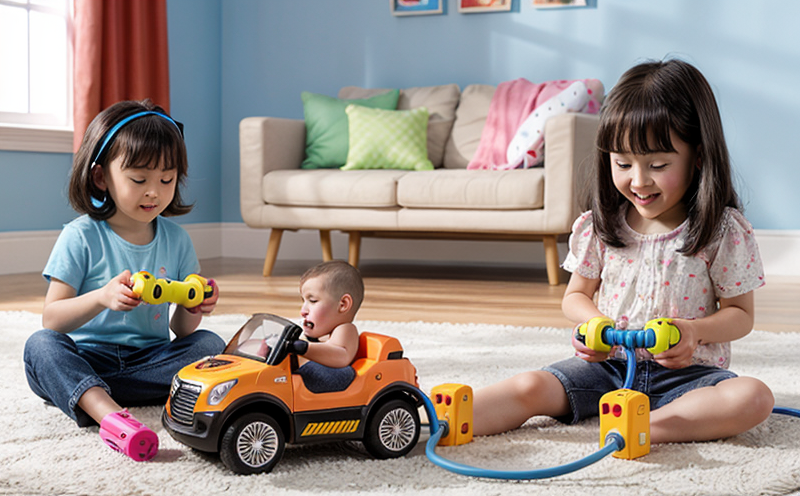EN 62115 Radiation and Electromagnetic Field Safety
The European Standard EN 62115: "Safety of toy electrical equipment and battery-operated toys with respect to radio interference" is a crucial document for ensuring the safety and compliance of electronic toys. This standard addresses potential risks related to electromagnetic compatibility (EMC) and radiation, which are critical in safeguarding children's health and well-being.
EN 62115 ensures that electrical and battery-operated toys do not emit harmful levels of electromagnetic interference or radio waves that could interfere with other electronic devices. This standard applies particularly to toys designed for use by children under the age of three, as their cognitive development makes them more susceptible to potential hazards.
The compliance process involves several steps, including understanding the applicable sections of EN 62115 relevant to your product, conducting necessary tests, and preparing documentation. It is essential to perform EMC testing in controlled environments using appropriate equipment such as an anechoic chamber for accurate measurement of electromagnetic emissions.
Testing procedures typically include measuring the conducted emissions from power lines, radiated emissions, and immunity against external electrical interference. These tests help identify any potential issues before the toy reaches the market. Compliance with EN 62115 helps manufacturers avoid recalls or safety alerts that could damage their reputation and potentially lead to legal action.
For R&D engineers working on new toys, understanding this standard ensures they design products that meet regulatory requirements from the outset. This proactive approach can save time and resources by avoiding costly redesigns later in the development process. Quality managers responsible for ensuring product safety and compliance will find EN 62115 invaluable as it provides clear guidelines on how to test for electromagnetic interference.
In summary, complying with EN 62115 is essential for any manufacturer of electrical or battery-operated toys intended for children under three years old. By adhering to this standard, companies not only protect consumers but also enhance their reputation and market position by demonstrating a commitment to safety and quality.
Benefits
Compliance with EN 62115 offers numerous benefits for toy manufacturers:
- Enhanced Safety: Ensures toys do not emit harmful levels of electromagnetic interference or radio waves, protecting children's health.
- Market Access: Facilitates easier entry into European markets where this standard is mandatory.
- Risk Mitigation: Reduces the risk of product recalls and safety alerts that can harm a company’s reputation.
- Customer Trust: Builds trust with consumers who value safety and quality in their products.
- Legal Protection: Provides legal protection against potential lawsuits related to product safety issues.
- Prompt Development: Facilitates prompt development of safe toys by providing clear guidelines for testing and design.
- Regulatory Compliance: Ensures strict adherence to European Union regulations, simplifying compliance with other standards as well.
In addition to these benefits, manufacturers who comply with EN 62115 can also anticipate reduced costs associated with potential recalls and increased customer satisfaction leading to improved brand loyalty.
Industry Applications
The application of EN 62115 is primarily focused on toy electrical equipment and battery-operated toys intended for use by children under three years old. This standard ensures that these products meet stringent safety requirements regarding electromagnetic interference (EMI) and radio frequency interference (RFI).
Manufacturers who adhere to this standard can confidently market their products as safe and compliant with international standards, thereby enhancing consumer trust and satisfaction. The testing procedures outlined in EN 62115 help identify potential issues early in the product development cycle, saving time and resources that would otherwise be spent on addressing these problems post-launch.
For R&D engineers, this standard provides a framework for designing toys that meet stringent safety requirements from the outset. Quality managers can use it to ensure strict adherence to these standards during production processes. By doing so, companies can avoid costly recalls and safety alerts while maintaining their reputation as responsible corporate citizens.
The scope of EN 62115 includes various aspects such as conducted emissions, radiated emissions, and immunity against external electrical interference. These tests are crucial for ensuring that toys do not emit harmful levels of electromagnetic radiation or interfere with other electronic devices. By conducting thorough testing in controlled environments like anechoic chambers, manufacturers can ensure their products comply with this standard.
In conclusion, EN 62115 plays a vital role in promoting the safety and well-being of children by ensuring that toys they play with do not pose any risks related to electromagnetic interference or radio waves. This standard is essential for toy manufacturers operating within Europe and looking to expand their markets beyond it.





